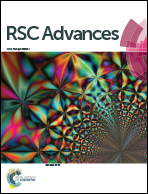Removal of Cr(vi) and p-chlorophenol and generation of electricity using constructed wetland-microbial fuel cells based on Leersia hexandra Swartz: p-chlorophenol concentration and hydraulic retention time effects†
Abstract
Heavy metals and phenolic compounds existing in polluted wastewater are a threat to the environment and human safety. A downflow Leersia hexandra Swartz constructed wetland-microbial fuel cell (DLCW–MFC) was designed to treat polluted wastewater containing Cr(VI) and p-chlorophenol (4-CP). To determine the effect of 4-CP concentration and hydraulic retention time (HRT) on the performance of the DLCW–MFC system, the wastewater purification, electricity generation, electrochemical performance, and L. hexandra growth status were studied. Addition of 17.9 mg L−1 4-CP improved the power density (72.04 mW m−2) and the charge transfer capacity (exchange current, 4.72 × 10−3 A) of DLCW–MFC. The removal rates of Cr(VI) and 4-CP at a 4-CP concentration of 17.9 mg L−1 were 98.8% and 38.1%, respectively. The Cr content in L. hexandra was 17.66 mg/10 plants. However, a 4-CP concentration of 35.7 mg L−1 inhibited the removal of Cr(VI) and the growth of L. hexandra, and decreased the electricity generation (2.5 mW m−2) as well as exchange current (1.21 × 10−3 A) of DLCW–MFC. An increase in power density and removal of Cr(VI) and 4-CP, along with an enhanced transport coefficient of L. hexandra, was observed with HRT. At an optimal HRT of 6.5 d, the power density, coulomb efficiency, and exchange current of DLCW–MFC were 72.25 mW m−2, 2.38%, and 4.99 × 10−3 A, respectively. The removal rates of Cr(VI) and 4-CP were 99.0% and 78.6%, respectively. The Cr content and transport coefficient of L. hexandra were 4.56 mg/10 plants and 0.451, respectively. Thus, DLCW–MFC is a promising technology that can be used to detoxify polluted wastewater containing composite mixtures and synchronously generate electricity.



 Please wait while we load your content...
Please wait while we load your content...